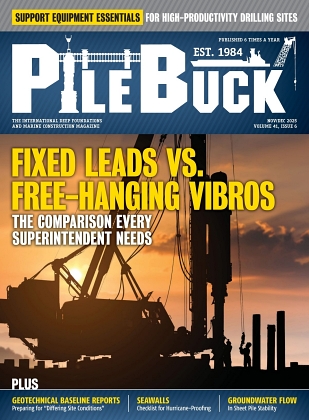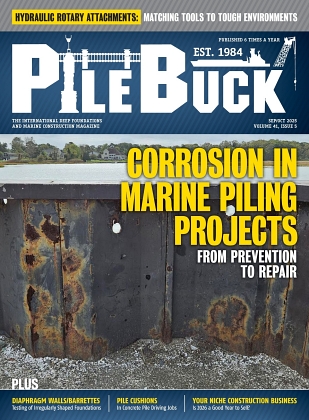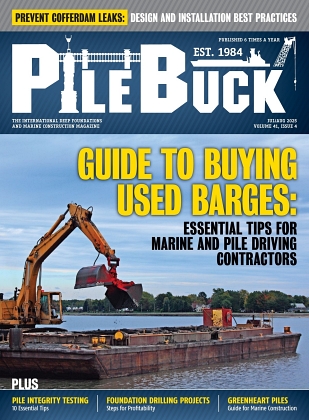Designing and Installing Sheet Piling for Storm Protection

View the complete article here.
Storm protection is a critical consideration in marine construction, where the relentless forces of nature can cause significant damage to coastal structures and ecosystems. Effective storm protection not only safeguards infrastructure but also protects lives, property, and the environment—ensuring the sustainability and resilience of coastal communities.
Over the decades, sheet piling has emerged as a reliable and versatile method for storm protection in marine environments. This technique involves driving prefabricated sections of sheet materials—typically steel, vinyl, or composite—into the ground to form a continuous barrier. These barriers serve multiple purposes, from preventing coastal erosion and managing flood risks to supporting embankments and retaining walls. The strength and adaptability of sheet piling make it an ideal choice for fortifying coastal defenses against the destructive power of storms.
Although this article will not discuss the various types of sheet piling in fine detail, you can learn more about the various types in detail here. Instead, this article will address the pivotal role of sheet piling in storm protection—offering insights into its design, installation, and maintenance—along with cost considerations, environmental impacts, and more.
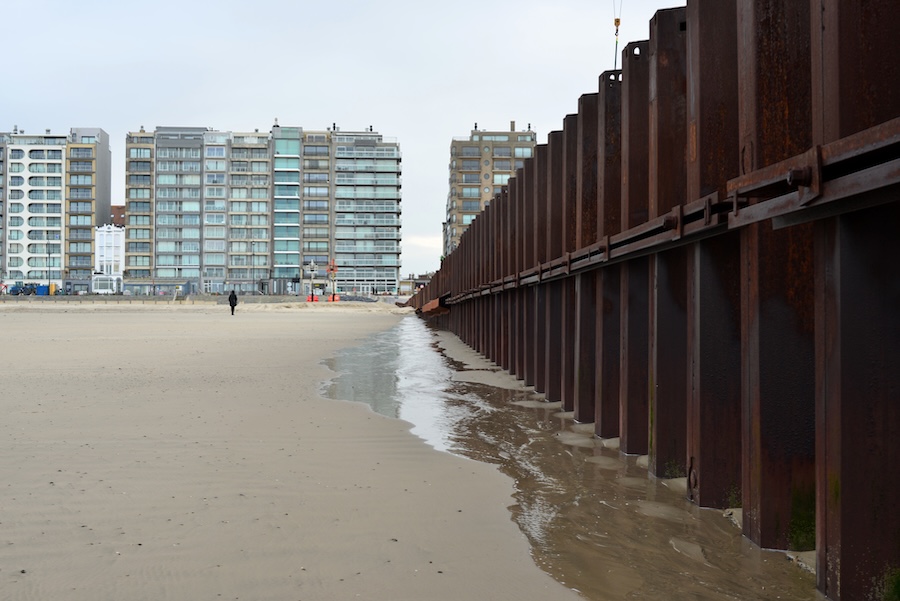
Role of Sheet Piling in Storm Protection
Sheet piling plays a crucial role in storm protection by creating a sturdy barrier that can withstand the forces of water and prevent soil erosion. When storms hit coastal areas—the combination of strong winds, high waves, and heavy rainfall can lead to severe erosion and flooding. Sheet piles, driven deep into the ground, form a continuous wall that resists these forces—protecting the shoreline and maintaining the integrity of the land. By doing so, sheet piling not only preserves the natural landscape but also protects infrastructure and property from storm damage.
Example 1: Coastal Erosion Control
In areas prone to coastal erosion, sheet piling has proven to be an effective solution. For instance, on a stretch of coastline facing significant erosion due to strong tidal actions and storm surges—steel sheet piles were installed to create a robust seawall. This seawall acted as a barrier, absorbing the impact of waves and preventing the soil from being washed away. Over time, the sheet piles helped stabilize the coastline—reducing the rate of erosion and preserving the beach and nearby properties.
Example 2: Flood Defense Systems
Sheet piling is also widely used in flood defense systems to protect low-lying areas from flooding. In a recent project, a flood-prone city installed vinyl sheet piles along its riverbanks to prevent river water from overflowing into residential and commercial areas during heavy rains. The vinyl sheet piles, known for their resistance to corrosion and flexibility, provided a reliable barrier against the rising water levels. This flood defense system successfully protected the city from severe flooding, demonstrating the effectiveness of sheet piling in managing stormwater and safeguarding urban areas.
Designing Sheet Piling for Storm Protection
Designing sheet piling structures for storm protection requires careful consideration of various factors to ensure their effectiveness and durability. The key considerations include:
- Soil conditions: Understanding the soil properties where the sheet piles will be installed is crucial. The soil must have adequate strength to support the sheet piles and resist the forces exerted by water and waves. Soil tests should be conducted to determine the soil type, density, and bearing capacity—which will influence the design and selection of sheet piles.
- Water levels and wave action: The design must account for the maximum anticipated water levels and the intensity of wave action during storms. This includes analyzing tidal patterns, storm surge heights, and wave forces. Properly designed sheet piling should extend deep enough into the ground to withstand the maximum expected water pressure and wave impact without failure.
- Environmental impact: The potential environmental impact of installing sheet piles must be assessed and mitigated. This involves evaluating how the structure will affect local ecosystems, sediment transport, and water quality. Measures should be taken to minimize habitat disruption and prevent negative ecological consequences.
Design Standards and Guidelines
Design standards and guidelines to be considered include:
- Relevant codes and regulations: Adhering to local, national, and international codes and regulations is essential in designing sheet piling structures. These standards ensure that the design meets safety, durability, and environmental requirements. Examples include the American Society for Testing and Materials (ASTM) standards and the Eurocode for geotechnical design.
- Best practices for design: Incorporating best practices in the design process enhances the reliability and performance of sheet piling structures. This includes using advanced modeling and simulation tools to predict the behavior of the sheet piles under various storm conditions, selecting appropriate materials based on site-specific conditions, and considering factors such as corrosion resistance and ease of installation. Regular inspections and maintenance plans should also be integrated into the design to ensure long-term functionality.

Installation of Sheet Piling for Storm Protection
Proper installation of sheet piling is critical to ensure its effectiveness in storm protection. This process involves several key steps, specialized equipment, and techniques to address common challenges and ensure a durable and reliable structure.
Step-by-Step Installation Process
The step-by-step installation process includes:
- Site assessment and preparation: The first step in installing sheet piling is to conduct a thorough site assessment. This includes surveying the area to identify any obstacles, evaluating soil conditions, and planning the layout of the sheet piles. Preparation may involve clearing debris, leveling the ground, and marking the positions where the sheet piles will be driven.
- Driving the sheets: Once the site is prepared, the sheet piles are driven into the ground. This is typically done using specialized equipment such as vibratory hammers, impact hammers, or hydraulic presses. The method chosen depends on the soil conditions and the type of sheet piling material. The sheets are driven to the required depth, ensuring they are interlocked properly to form a continuous barrier.
- Anchoring and bracing: To enhance stability and ensure the sheet piles can withstand storm forces, anchoring and bracing are crucial. This involves installing anchors to secure the sheet piles and adding braces to distribute the loads evenly. Anchors can be driven into the ground behind the sheet piles, and braces are placed at intervals to prevent lateral movement. Proper anchoring and bracing are essential for maintaining the integrity of the structure during extreme weather conditions.
Equipment and Techniques Used in Installation
The installation of sheet piling requires various types of equipment and techniques to ensure precision and effectiveness. Vibratory hammers are commonly used for their efficiency in driving sheets into the ground with minimal disturbance. Impact hammers are employed for tougher soil conditions where more force is needed. Hydraulic presses offer a quieter and more controlled installation method. In addition, laser levels and GPS technology are often used to maintain alignment and accuracy during installation.
Challenges and Solutions in Installation
Installing sheet piling for storm protection presents several challenges—including dealing with hard or rocky soils, ensuring proper alignment, and managing environmental impacts. Solutions to these challenges involve selecting the appropriate equipment and techniques for the specific site conditions. For example, pre-drilling holes can facilitate driving sheets into hard soils. Using guide frames and templates helps maintain alignment. Environmental challenges can be addressed by implementing best practices to minimize disruption, such as using silt curtains to control sedimentation and choosing materials with lower ecological impacts. Regular monitoring and adjustments during the installation process also contribute to overcoming these challenges and achieving a successful outcome.
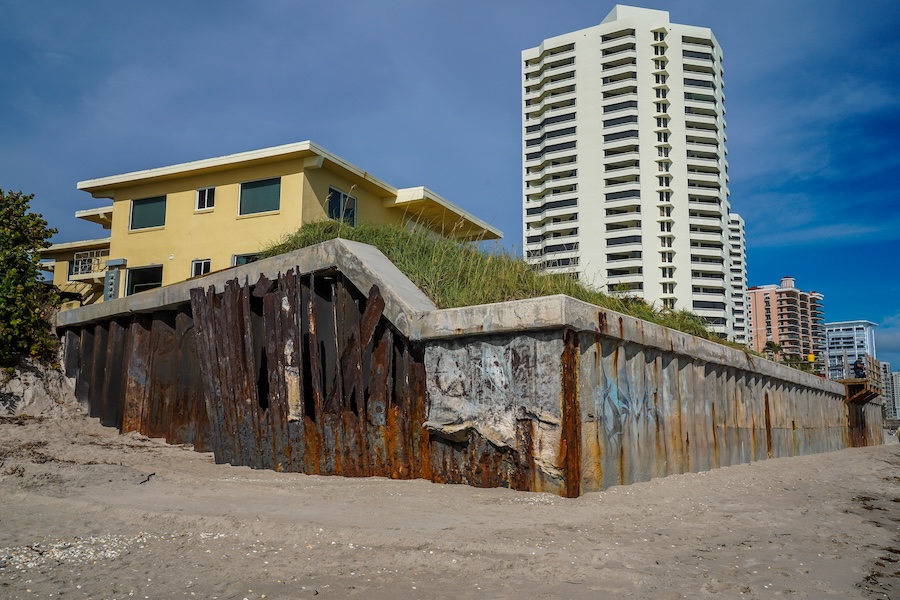
Maintenance and Inspection of Sheet Piling
Regular maintenance and inspection of sheet piling are crucial to ensure its long-term effectiveness and durability. These practices help identify and address potential issues before they become significant problems, thereby extending the lifespan of the structure and maintaining its protective capabilities.
Importance of Regular Maintenance and Inspection
Regular maintenance and inspection are vital to ensure that sheet piling remains effective in storm protection. These activities help detect early signs of wear-and-tear, corrosion, and structural damage—allowing for timely repairs and preventive measures. By maintaining the integrity of sheet piling, contractors can avoid costly repairs and replacements.
Common Maintenance Practices
When it comes to storm protection, common maintenance practices for sheet piling should include:
- Rust prevention: Steel sheet piles are susceptible to rust and corrosion, especially in marine environments. Applying protective coatings, such as epoxy or galvanization, can prevent rust formation. Regular cleaning to remove salt deposits and other corrosive elements is also essential.
- Checking for structural integrity: Regular inspections should include checking for any signs of bending, cracking, or displacement in the sheet piles. Ensuring that the interlocks between sheets remain tight and secure is critical to maintaining the structure’s overall stability.
Inspection Techniques and Frequency
Inspection techniques for sheet piling include visual inspections, non-destructive testing (NDT) methods, and underwater inspections for submerged sections. Visual inspections involve looking for visible signs of damage, corrosion, or misalignment. NDT methods, such as ultrasonic testing, can detect internal defects without damaging the piles. Underwater inspections may require divers or remotely operated vehicles (ROVs) to assess the condition of submerged sheet piles. The frequency of inspections depends on the environmental conditions and the age of the structure, but a general guideline is to conduct thorough inspections at least once a year—with more frequent checks after significant storm events.
Cost Considerations
When planning sheet piling projects for storm protection, understanding the various cost factors is crucial for budgeting and decision-making. These costs encompass material, installation, and ongoing maintenance expenses—all of which contribute to the overall investment in the project.
Cost Factors Involved in Sheet Piling Projects
The most common factors include:
- Material costs: The choice of material significantly affects the cost of sheet piling. Steel sheet piles are typically more expensive due to their strength and durability, whereas vinyl and composite sheet piles might offer a more cost-effective solution depending on the project’s requirements. In addition, material costs can vary based on market conditions and the specific type of sheet piling used.
- Installation costs: Installation expenses include labor, equipment, and site preparation. The complexity of the installation process, such as the need for specialized equipment or challenging site conditions, can drive up costs. For example, driving sheet piles into hard or rocky soils may require more powerful machinery and longer installation times—increasing overall expenses.
- Maintenance costs: Regular maintenance is essential to ensure the longevity and effectiveness of sheet piling. Maintenance costs cover activities such as rust prevention, inspections, and repairs. While these costs are ongoing, investing in proper maintenance can prevent more significant and costly issues in the future.
Cost-Benefit Analysis of Using Sheet Piling for Storm Protection
Conducting a cost-benefit analysis helps determine the value of investing in sheet piling for storm protection. While the initial costs of materials and installation may be high—the benefits of reduced storm damage, increased property protection, and long-term durability often outweigh these expenses. Effective storm protection can prevent costly repairs and losses from storm damage, providing significant savings over time. In addition, the reliability and longevity of sheet piling can offer peace of mind—knowing that coastal infrastructure is well-protected against severe weather events.
View the complete article here.
What are the benefits of using sheet piling for storm protection?
Sheet piling effectively prevents coastal erosion, manages flood risks, and protects infrastructure from storm damage.
How does the installation process of sheet piling ensure its effectiveness in storm protection?
Proper installation involves site preparation, driving sheets into the ground, and anchoring/bracing to withstand storm forces.

